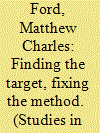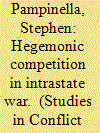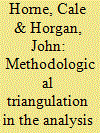|
|
|
Sort Order |
|
|
|
Items / Page
|
|
|
|
|
|
|
| Srl | Item |
| 1 |
ID:
110004


|
|
|
|
|
| Publication |
2012.
|
| Summary/Abstract |
This article examines the factors that have contributed to the end of the Red Army Faction (RAF), and places particular emphasis on the causes and characteristics of individual disengagement of RAF members from the armed struggle. It discusses the evolution, ideology, and decline of each of the three generations of the RAF. The article's contribution is twofold. First, by assessing both contextual- and individual-level factors that led to the group's demise, the article bridges two approaches to analyzing the demise of terrorist organizations-the literature on how terrorism ends and why individuals disengage from terrorism. Second, the article helps build a growing empirical body of work on the demise of terrorist groups that can be used to confirm, challenge, or refine existing hypotheses on how terrorism ends, while formulating new ones. The article concludes that different factors contributed to the decline of each subsequent generation of the RAF. Successful German police efforts played a critical role in thwarting the RAF's first generation. Lack of public support and recruits, due in large part to an escalation of terrorist violence, hastened the decline of the second generation of the group. The third generation suffered from serious interorganizational strife, exacerbated by a government initiative that offered to release those RAF members from prison who renounced terrorism.
|
|
|
|
|
|
|
|
|
|
|
|
|
|
|
|
| 2 |
ID:
110002


|
|
|
|
|
| Publication |
2012.
|
| Summary/Abstract |
This article is concerned with exploring the recent observations of Lieutenant-General Lamb who stated that there was no simple binary between counterintelligence (COIN) and counterterrorism (CT). Specifically, the article will use the intelligence-gathering, assessment, and target identification processes and methods used on operations in Iraq and Afghanistan to examine this further. What makes this an interesting exercise is that the effectiveness of a COIN/CT intervention totally depends on whether an insurgent has been properly identified. If the wrong person has been targeted then kinetic, influence, or policing activities are at best exploratory and at worst wasteful or even positively harmful. Thus, by investigating the intelligence model that frames the way adversaries and communities are identified, it becomes possible to understand the limitations in the processes and methods used. At the same time this approach makes it possible to cast light on how and to what extent various techniques drawn from COIN and CT work together in Overseas Contingency Operations.
|
|
|
|
|
|
|
|
|
|
|
|
|
|
|
|
| 3 |
ID:
110001


|
|
|
|
|
| Publication |
2012.
|
| Summary/Abstract |
This article employs social constructivist approaches drawn from social movement theory and international relations to explain outcomes of insurgency and counterinsurgency. It argues that mobilizing civilians requires the formation of hegemonic social relations that legitimate coercive force in defense of the political community. Four social mechanisms are hypothesized to be relevant in the creation of hegemony: brokerage, diffusion, reflexive self-restraint, and self-fulfilling prophecies. This constructivist theory of hegemonic competition is then evaluated using a case study of insurgency and counterinsurgency in Iraq's al-Anbar province.
|
|
|
|
|
|
|
|
|
|
|
|
|
|
|
|
| 4 |
ID:
110005


|
|
|
|
|
| Publication |
2012.
|
| Summary/Abstract |
The conceptualization of terrorist groups as networks is increasingly common to terrorism studies, although methods of analysis vary widely. Contrary to common understandings, the integration of computational and qualitative methods is possible even with limited (small-n) data. The triangulation of different methods can produce insights overlooked by the use of any single method and validate findings across methods. This article demonstrates some of the possibilities for integrating qualitative and quantitative methods for network analysis using Raffaello Pantucci's recent article, "The Tottenham Ayatollah and The Hook-Handed Cleric: An Examination of All Their Jihadi Children."
|
|
|
|
|
|
|
|
|
|
|
|
|
|
|
|
| 5 |
ID:
110003


|
|
|
|
|
| Publication |
2012.
|
| Summary/Abstract |
Though the United States-led invasion of Iraq in March 2003 aimed to rapidly topple authoritarian leader Saddam Hussein via decisive victory, the unintended consequences of this historical event resulted in full-fledged sectarian warfare. Emerging out of this incident, the captivating populist figure Muqtada al-Sadr moved promptly to capture the spotlight for the Iraqi Shi'a. Muqtada al-Sadr's personal militia ultimately consolidated power under the designation Jaysh al-Mahdi with the sole objective of pushing Coalition Forces out of their cherished homeland. Despite its revolutionary disposition and use of violent tactics in the interim, Jaysh al-Mahdi is indeed a mere tool of Muqtada al-Sadr's strategic objectives, one that can be characterized as an Islamic activist movement striving to restore order to Iraq. After the Iraq invasion, Muqtada al-Sadr likely recognized the unfolding situation as the ideal opportunity to assume authority, in a lack thereof, in order to pursue his family's political goals for the Iraqi Shi'a. Militia members are fighting to win control of Iraq to install a Sadrist strain of governance, which would ensure their safety and protection from other elements of Iraqi society thereafter.
|
|
|
|
|
|
|
|
|
|
|
|
|
|
|
|
|
|
|
|
|